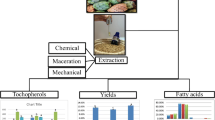Abstract
Karawila (Momordica charantia), also known as bitter gourd, is widely used as a food and a medicine in Asian countries. Representative samples of the seeds of the most abundant cultivar (MC43) in Sri Lanka were collected. The kernel represented 60 ± 4.7% of the seed by dry weight basis. The oil content of the dry kernel was 40.45 ± 3.12%. The seed oil was rich in α-eleosteric acid (50.04 ± 4.80%) and three other geometrical isomers of 9,11,13-octadecatrienoic acid that constituted 6.55%. The acid value, the saponification value and the iodine value were 2.73 ± 0.876, 190.70 ± 1.82 mg/g and 115.96 ± 3.46 cg/g, respectively. The set-to-touch drying time of 3 h observed for the seed oil of MC43 was significantly less than that of linseed oil (13 h). The presence of a high amount of conjugated octadecatrienoic acids, low acid value, high saponification value, moderate iodine value and the low set-to-touch drying time are promising indicators of the potential of karawila seed oil as a good drying oil for the paint and coating industry.


Similar content being viewed by others
References
Grover JK, Yadav SP (2004) Pharmacological actions and potential use of Momordica charantia: reviews. J Ethnopharmacol 93:123–132
Chang M-K, Conkerton EJ, Chapital DC, Wan PJ, Vadhwa OP, Spiers JM (1996) Chinese melon (Momordica charantia L.) seed: composition and potential use. J Am Oil Chem Soc 73:263–265
Suhail A, Amjad AK, Qayyum H (2005) Potential of immobilized bitter gourd (Momordica charantia) peroxidases in the decolorization and removal of textile dyes from polluted waste water and dyeing effluent. Chemosphere 60:291–301
Suhail A, Qayyum H (2006) Potential applications of immobilized bitter gourd (Momordica charantia) peroxidase in the removal of phenols from polluted water. Chemosphere 65:1228–1235
Mary JC, Hopkins CY (1964) Fatty acid composition of some Cucurbitaceae seed oils. Can J Chem 42:560–564
Aggarwal JS and Sharma PG (1956) Air drying wrinkle varnishes. US patent 2,749,247
Chirag MJDD, Vijeyaraj AD, Kallappa MH (1992) Unusual fatty acids of Cordia rothii seed oil. J Sci Food Agric 58:285–286
Conkerton EJ, Wan PJ, Richard OA (1995) Hexane and heptane as extraction solvents for cottonseed: a laboratory-scale study. J Am Oil Chem Soc 72:963–965
Kamel SB, Kakuda Y (1992) Characterization of the seed oil and meal from apricot, cherry, peach and plum. J Am Oil Chem Soc 69:492–494
John MD, Dorselyn CC, Jui-Chang WK, Robert TM, Charlotta T, Tomas AM, Armand BP (2002) Molecular analysis of a bifunctional fatty acid conjugated/desaturase from Tung. Implications for the evolution of plant fatty acid diversity. Plant Physiol 130:2027–2038
Svein AM, Pettersen J (2003) Determination of trans double bonds in polyunsaturated fatty acid methyl esters from their electron impact mass spectrum. Eur J Lipid Sci Technol 105:156–164
Gomze K, Huseyin Y (2005) Analysis of the fixed oils of the genus Nigella L. (Ranunculaceae) in Turkey. Biochem Syst Ecol 33:1203–1209
Link WE (1959) General methods of analysis of drying oils. J Am Oil Chem Soc 36:477–483
Paint testing manual (1972) ASTM special technical publication 500
Paschke RF, Tolberg W, Wheeler DH (1953) Cis, trans isomers of the eleostearate isomers. J Am Oil Chem Soc 30:97–99
O’Connor RT, Heinzelaman DC, Freeman AF, Pack FC (1945) Spectrophotometric determination of α-eleosteric acid in freshly extracted tung oil. Ind Eng Chem Res 17:467–470
John SH, O’Connor RT, Heinzelaman DC, Bicford WG (1957) A simplified method for the preparation of α- and β-eleosteric acids and revised spectrophotometric procedure for their determination. J Am Oil Chem Soc 34:338–342
Volkes S, Werner T, Monica Z (1996) Identification of α-parinaric acid in the seed oil of Sebastiana brasiliensis sprenge. J Am Oil Chem Soc 73:569–573
Toru T, Yutaka I (1981) Occurrence of mixtures of geometrical isomers of conjugated octadecatrienoic acids in some seed oils: analysis by open-tabular gas liquid chromatography and high performance liquid chromatography. Lipids 16:546–551
Author information
Authors and Affiliations
Corresponding author
About this article
Cite this article
Prashantha, M.A.B., Premachandra, J.K. & Amarasinghe, A.D.U.S. Composition, Physical Properties and Drying Characteristics of Seed Oil of Momordica charantia Cultivated in Sri Lanka. J Am Oil Chem Soc 86, 27–32 (2009). https://doi.org/10.1007/s11746-008-1319-6
Received:
Revised:
Accepted:
Published:
Issue Date:
DOI: https://doi.org/10.1007/s11746-008-1319-6




